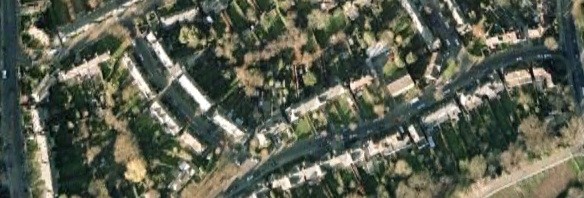History

Roe Green Village is a vibrant community and conservation area in North West London. Originally built in 1916 for the workers of the nearby aircraft factories, the village was designed as a 'Garden Village' in the Arts and Craft style by Sir Frank Baines and to this day it maintains a village like atmosphere.
The information below gives a fuller background to the history of this village.
Also you will find out how Roe Green Village Day, our annual event, first got started and how celebrations go back to HM The Queen's Silver and Golden Jubilees and in 2012, HM The Queen's Diamond Jubilee.
Articles and pictures from a visit made by HRH The Queen Mother back in 1986 to Goldsmith Lane can be seen on this website.
Did you live in the village between 1920 and 1945?
If so, please get in touch: contact@roegreenvillage.org.uk
Timeline
In 1915 the Aircraft Manufacturing Company occupied over 9,000m2 (100,000 ft2) of factory employing 600 people (not including administrative staff) and was producing 20 machines per month.
By 1918 their premises comprised almost 70,000m2 (730,000 ft2) employing 4,400 people assembling 190 machines each month. This sudden and dramatic increase in employment necessary for increased aircraft output brought problems of living accommodation and public transport to what had hitherto been a relatively isolated country area.
The premises now occupied by 'Kingswood Kitchens' – at the Edgware Road end of Grove Park – are what remains of the Airco aeroplane factory. The Imperial War Museum has a picture, painted in 1918, showing the inside of one of the big factory sheds and the men and women workers assembling De Havilland biplane bombers. Some of these workers were, of course, the original residents of Roe Green Village. See BBC History – Art and Daily Life in World War Two for further details.
This means that there are actually quite substantial remains of the original Airco factory, if you include the adjacent Beis Yacov Jewish School on Edgware Road, which was formerly the HQ offices of Airco. Since not very much survives on the opposite (Barnet) side of Edgware Rd, we have a significant part of the area's surviving First World War aircraft manufacturing heritage in the borough.
In 1916, the Office of Works commissioned its principal architect, Sir Francis Baines, C.B.E., M.V.O., (1877 – 1933), to design an estate of cottages for the aircraft workers. This was done along "garden village" lines at Roe Green. The term "garden village" represented an important concept of estate design. British Town Planning was in its infancy and there were few controls on building form save the local bye-laws. In this regard, the work of Baines should be judged in the context of the Garden City movement inspired by Ebenezer Howard. Baines' concept of estate design was refined with practice. Roe Green itself was based on his office's design for Woolwich Garden Suburb (the Well Hall Estate) which was built for the Arsenal (the Ordnance factory not the football club) in 1915.
In 1968 the local authority designated Roe Green Village a Conservation Area in order to "preserve and enhance" its unique character.
